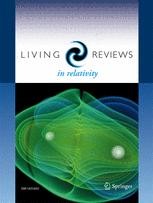Living Reviews in Relativity: "Relativistic dynamics and extreme mass ratio inspirals"
 Amaro-Seoane, P., "Relativistic dynamics and extreme mass ratio inspirals", Living Rev Relativ (2018) 21: 4. https://doi.org/10.1007/s41114-018-0013-8
Amaro-Seoane, P., "Relativistic dynamics and extreme mass ratio inspirals", Living Rev Relativ (2018) 21: 4. https://doi.org/10.1007/s41114-018-0013-8
Open Access | Review Article
First Online: 15 May 2018
Abstract:
It is now well-established that a dark, compact object, very likely a massive black hole (MBH) of around four million solar masses is lurking at the centre of the Milky Way. While a consensus is emerging about the origin and growth of supermassive black holes (with masses larger than a billion solar masses), MBHs with smaller masses, such as the one in our galactic centre, remain understudied and enigmatic. The key to understanding these holes—how some of them grow by orders of magnitude in mass—lies in understanding the dynamics of the stars in the galactic neighbourhood. Stars interact with the central MBH primarily through their gradual inspiral due to the emission of gravitational radiation. Also stars produce gases which will subsequently be accreted by the MBH through collisions and disruptions brought about by the strong central tidal field. Such processes can contribute significantly to the mass of the MBH and progress in understanding them requires theoretical work in preparation for future gravitational radiation millihertz missions and X-ray observatories. In particular, a unique probe of these regions is the gravitational radiation that is emitted by some compact stars very close to the black holes and which could be surveyed by a millihertz gravitational-wave interferometer scrutinizing the range of masses fundamental to understanding the origin and growth of supermassive black holes. By extracting the information carried by the gravitational radiation, we can determine the mass and spin of the central MBH with unprecedented precision and we can determine how the holes “eat” stars that happen to be near them.
